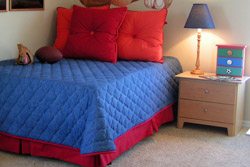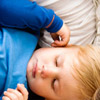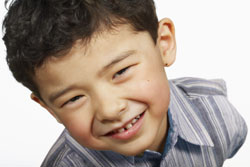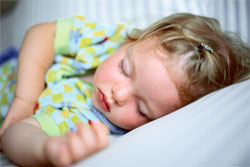- Introduction to Alarm Therapy
- What is a bed wetting alarm?
- How does the alarm work?
- How to use the alarm?
- How long does it take to work?
- Do bed wetting alarms work?
- Troubleshooting
- What if the alarm doesn’t work?
Introduction to Alarm Therapy

Enuresis is extremely common and affects 20% of 5 year olds, 10% of 10 year olds and 3% of 15 year olds. It has the ability to impact on self-esteem and limits a child’s ability to participate in social events such as sleepovers and school camps.
 |
For more information about the causes of bed wetting view the video: Causes of Bedwetting. |
Although our understanding of bed wetting is not complete, it is thought to arise from a combination of different factors including producing too much urine at night, overactivity of the detrusor muscle which makes up the bladder wall and reduced production of a hormone called vasopressin or anti-diuretic hormone (ADH) at night.
The exact mechanism behind bed wetting is not clearly understood, but is thought to result from a combination of three key factors which include:
- Difficulty waking from deep sleep;
- Producing too much urine at night; and
- Overactivity of the detrusor muscle which makes up part of the bladder wall.
 |
Video about how the difficulty rousing from sleep can cause children to wet the bed. |
 |
Video on how overproduction of urine can cause children to wet the bed. |
 |
Video on how an overactive or twitchy bladder can cause bedwetting. |
There are several options available for treatment of bedwetting. The use of a bed wetting alarm is generally the first step for families who are motivated and have time to dedicate to using an alarm. A medicine called desmopressin is an alternative for families who are unlikely to comply with alarm therapy, where alarm therapy has failed or where a quicker response is required. If your child does not become dry with either a bed wetting alarm or the use of desmopressin medication, your doctor will tell you about other medications including anticholinergics or tricyclic antidepressants which can also be used to treat bed wetting.
 |
For more information about what causes bed wetting and how it can be treated, see Nocturnal Enuresis (Bed Wetting).
|
What is a bed wetting alarm?
A bed wetting alarm consists of a sensor which triggers an alarm when urine comes into contact with it. There are two types of bed wetting alarms available in Australia. The first alarm type uses a large pad which is placed in the bed and triggers a loud alarm when liquid comes into contact with it. The second type attaches either directly to your child’s underpants or to an absorbent pad placed inside their underpants and is triggered when liquid comes into contact with the sensor. Other alarm options include a voice recorded message, bright flashing lights or a vibrating trigger.
How does the alarm work?
The exact mechanism by which alarm therapy works is not completely understood. It is thought to heighten arousal and increase the volume of urine that the bladder can store over time. In children who wet the bed alarm therapy aims to achieve three key goals:
- Trains the child to recognise the need to pass urine;
- Trains the child to wake and go to the toilet at night; and
- Trains the child over time to wake to hold on and stop wetting the bed.
 |
For more information about how urine is produced and regulated in the body, see Urinary Tract. |
How to use the alarm?

When urine comes into contact with the sensor the alarm will sound. You will need to ensure that your child wakes to the alarm, help to turn the alarm off and disconnect your child so that they can use the toilet. Any wet clothing and bed linen should then be changed and your child reconnected to the alarm and put back to bed. Initially you will need to help your child through this sequence but with time they will learn the routine.
It is a good idea to have a test run before you use the alarm for the first time. You and your child can practise the sequence using a glass of water. You may need to remind your child of the sequence before bed each night until it becomes familiar.
How long does it take to work?
Alarm therapy may take 2–3 months to work. It is imperative that the alarm is used every night with consistency being the key. In the early stages, signs that the alarm is working may include smaller wet patches, your child waking to the alarm, the alarm going off later or fewer times per night and fewer wet nights per week. Once dryness is achieved the alarm needs to be continued until a minimum of 2 weeks of consecutive dry nights have been achieved.
Two additional components have shown to reduce the risk of relapse once dryness has been achieved. Overlearning involves giving extra fluid at bed time and continuing alarm treatment until 14 consecutive nights of dryness are achieved with this additional bladder load. Dry bed training involves waking the child every hour to use the toilet for 1 night and having the child change the linen if they wet the bed. On subsequent nights, the child is woken once and taken to the toilet with the aim being to wake the child progressively earlier each night.
Do bed wetting alarms work?
A large study which looked at 3,257 children who wet their beds found that about two thirds of children who used an alarm became dry when compared to children who didn’t use an alarm. Of those who persisted with the alarm, half remained dry after the alarm was ceased. The addition of overlearning and dry bed training helped to reduce relapse rates.
Factors that are likely to negatively impact on your child’s success with alarm therapy include your own acceptance of the alarm, your child having behavioural problems and if punishment is administered for bed wetting.
Troubleshooting

You should receive adequate information for operating the alarm and details of who to contact if you encounter problems. You will initially need to wake your child up when the alarm goes off and may need to sleep in the same room as them to make this easier. If your child is frightened of the alarm, try using a recorded message or a vibrating sensor instead. Bed wetting alarms can be hired from local paediatric hospitals and health care clinics for a small cost.
What if the alarm doesn’t work?
If your child has had no response to the alarm after 3 months of continuous treatment it is important to return to your doctor. It is not recommended to continue with the alarm past this point unless your child is improving or you are motivated to continue with the alarm.
A range of other treatment options are available for children who do not achieve dryness with a bedwetting alarm. These include a medication called desmopressin and either anticholinergics and/or tricyclic antidepressants where desmopressin or alarm therapy has not worked. These medications are often used successfully when combined with a bed wetting alarm.
In children who return to wetting the bed after successful alarm therapy or who have tried an alarm previously with no success, another course of alarm therapy may be suggested.
If your child has not responded to treatment with either a bed wetting alarm or desmopressin after 8–12 weeks it is recommended that you be referred to a specialist.
References
- Neveus T, Von Gontard A, Hoebeke P et al. The standardization of terminology of lower urinary tract function in children and adolescents: report from the standardisation committee of the International Children’s Continence Society. The Journal of Urology 2006 (176): 314-324. [Abstract | Full Text]
- Bottomley G. Treating nocturnal enuresis in children in primary care. The Practitioner 2011 (255): 23-26. [Abstract]
- Bower F, Moor K, Shepherd R et al. The epidemiology of enuresis in Australia. British Journal of Urology 1996 (78): 602-606. [Abstract]
- Schulpen T. The burden of nocturnal enuresis. Acta Paediatrica 1997 (86): 981-984. [Abstract]
- Keuhhas F, Djakovic N, Hohenfellner. Infantile enuresis: current state-of-the-art therapy and future trends. Reviews in Urology 2011 (13): 1-5. [Abstract | Full Text]
- Neveus T, Eggert P, Evans et al. Evaluation and treatment of monosymptomatic enuresis: a standardisation document from the international children’s continence society. The Journal of Urology 2010 (183): 441-447. [Abstract | Full Text]
- National Institute for Health and Clinical Excellence. NICE clinical guideline 111 – Nocturnal Enuresis: the management of bedwetting in children and young people. Issue date October 2010. Available from [URL Link]
- Glazener C, Evans J, Peto R. Alarm interventions for nocturnal enuresis in children. The Cochrane Collaboration 2009. Issue 1. [Abstract]
- Caldwell P, Edgar D, Hodson E et al. Bedwetting and toileting problems in children. Medical Journal of Australia 2005 (182): 190-195. [Abstract | Full Text]
- Bedwetting Institute. Available from [URL Link]
- Neveus T. Nocturnal enuresis – theoretic background and practical guidelines. Paediatric Nephrology 2011 (26): 1207-1214. [Abstract | Full Text]
- Taneli C, Ertan P, Taneli F. Effect of alarm treatment on bladder storage capacities in monosymptomatic nocturnal enuresis. Scandinavian Journal of Urology 2004 (38): 207-210. [Abstract]
- Royal Children’s Hospital. Bedwetting Fact Sheet. Last updated October 2010. Available from: [URL Link]
All content and media on the HealthEngine Blog is created and published online for informational purposes only. It is not intended to be a substitute for professional medical advice and should not be relied on as health or personal advice. Always seek the guidance of your doctor or other qualified health professional with any questions you may have regarding your health or a medical condition. Never disregard the advice of a medical professional, or delay in seeking it because of something you have read on this Website. If you think you may have a medical emergency, call your doctor, go to the nearest hospital emergency department, or call the emergency services immediately.







